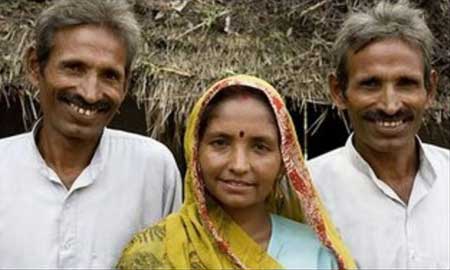 |
|
Aid workers say the practice of female feticide has flourished among several communities across the country.(Agencies) |
|
When Munni arrived in this fertile, sugarcane-growing region of north India as a young bride years ago, little did she imagine she would be forced into having sex and bearing children with her husband's two brothers who had failed to find wives. "My husband and his parents said I had to share myself with his brothers," said the woman in her mid-40s, dressed in a yellow sari, sitting in a village community center in Baghpat district in the northern state of Uttar Pradesh. "They took me whenever they wanted -- day or night. When I resisted, they beat me with anything at hand," said Munni, who had managed to leave her home after three months only on the pretext of visiting a doctor. "Sometimes they threw me out and made me sleep outside or they poured kerosene over me and burned me." Such cases are rarely reported to police because women in these communities are seldom allowed outside the home unaccompanied, and the crimes carry deep stigma for the victims. So there may be many more women like Munni in the mud-hut villages of the area. Munni, who has three sons from her husband and his brothers, has not filed a police complaint either. Social workers say decades of aborting female babies in a deeply patriarchal culture has led to a decline in the population of women in some parts of India, like Baghpat, and in turn has resulted in rising incidents of rape, human trafficking and the emergence of "wife-sharing" amongst brothers. Aid workers say the practice of female feticide has flourished among several communities across the country because of a traditional preference for sons, who are seen as old-age security. "We are already seeing the terrible impacts of falling numbers of females in some communities," says Bhagyashri Dengle, executive director of children's charity Plan India. "We have to take this as a warning sign and we have to do something about it or we'll have a situation where women will constantly be at risk of kidnap, rape and much, much worse." According to India's 2011 census, there are only 858 women to every 1,000 men in Baghpat district, compared to the national sex ratio of 940. Child sex ratios in Baghpat are even more skewed and on the decline with 837 girls in 2011 compared to 850 in 2001. "In every village, there are at least five or six bachelors who can't find a wife. In some, there are up to three or four unmarried men in one family. It's a serious problem," says Shri Chand, 75, a retired police constable. (Read by Lee Hannon. Lee Hannon is a journalist at the China Daily Website.) (Agencies)
|
若干年前,當(dāng)年輕的穆尼嫁到印度北部這片富饒的甘蔗盛產(chǎn)區(qū)時(shí),她從未想到自己的丈夫會(huì)和兩個(gè)娶不到老婆的兄弟“共妻”,并生養(yǎng)子女。 40多歲的穆尼說(shuō):“我的丈夫和公婆逼我做他們兄弟三人的老婆。”當(dāng)時(shí)她穿著黃色的沙麗,坐在印度北方邦巴格帕特區(qū)一個(gè)村落的活動(dòng)中心。 穆尼說(shuō):“他們不分白天黑夜地折磨我。如果我反抗,他們隨手抄起東西就打我。”三個(gè)月后,以看醫(yī)生為借口,穆尼才獲準(zhǔn)出家門(mén)。 “有時(shí)他們把我趕出來(lái),讓我睡在外面,還朝我潑煤油燒我。” 但警方很少接到報(bào)警,因?yàn)檫@些地區(qū)的女性通常不準(zhǔn)獨(dú)自出門(mén),而且對(duì)受害者來(lái)說(shuō),這是極大的恥辱。因此在該地區(qū)的泥棚村落里,還有更多女性的遭遇和穆尼類(lèi)似。 穆尼也沒(méi)有報(bào)警。她和丈夫兄弟三人生育了三個(gè)兒子。 社工表示,印度的族長(zhǎng)文化根深蒂固,幾十年來(lái)很多女?huà)氡粔櫶ィ@導(dǎo)致印度的巴格帕特等地區(qū)女性人數(shù)銳減,造成強(qiáng)奸和拐賣(mài)人口案例增多,以及兄弟“共妻”現(xiàn)象的出現(xiàn)。 義工表示,在印度很多地區(qū),女?huà)氡粔櫶ザ己芷毡椤S捎谛欧睢梆B(yǎng)兒防老”,人們存在重男輕女的傳統(tǒng)觀念。 兒童慈善團(tuán)體“印度計(jì)劃”的執(zhí)行理事長(zhǎng)巴格亞什利?登勒說(shuō):“一些地區(qū)女性人數(shù)減少,我們已經(jīng)看到了嚴(yán)重后果。” “我們必須對(duì)此引起重視,采取行動(dòng),否則印度的女性將一直身處誘拐、強(qiáng)奸,甚至更糟糕的環(huán)境中。” 根據(jù)印度2011年人口普查,在巴格帕特區(qū),男女性別比為1000比858,而印度全國(guó)的性別比為1000比940。 巴格帕特區(qū)的兒童性別比更加失衡,而且愈發(fā)嚴(yán)重。2011年兒童男女性別比為1000比837,而2001年這一數(shù)字為850。 75歲的退休警官什里?錢(qián)德說(shuō):“在每個(gè)村落都至少有五六個(gè)男的打光棍。在一些地區(qū),一個(gè)家庭里竟然有三四個(gè)光棍。問(wèn)題太嚴(yán)重了。” 相關(guān)閱讀 過(guò)去30年印度1200萬(wàn)女胎被流產(chǎn) 印度開(kāi)展人口普查 總?cè)丝诳蛇_(dá)12億 英國(guó)發(fā)布奧運(yùn)禮節(jié)指南:別擁抱印度人 (中國(guó)日?qǐng)?bào)網(wǎng)英語(yǔ)點(diǎn)津 Julie 編輯:陳丹妮) |
|
Vocabulary: sari: 紗麗,印度傳統(tǒng)服裝 on the pretext of: 以……為借口 stigma: 恥辱,污名 patriarchal: 族長(zhǎng)的,家長(zhǎng)的 |
